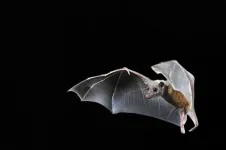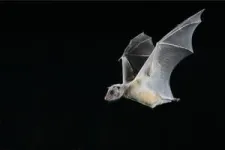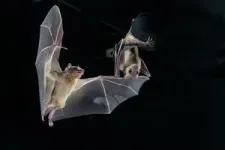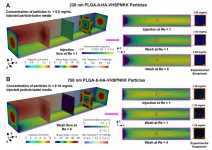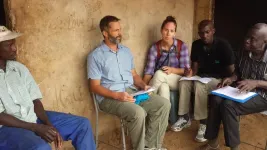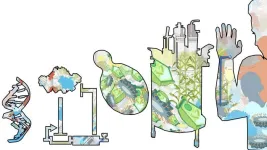(Press-News.org) Vienna, Austria: Researchers have found that nerve cells in the hippocampus region of the brain encode complex information on numerous characteristics of other individuals in the same social group.
The work, which is being carried out in bats, is the first to show this in a large, mixed-sex group of wild, social animals, and is important because it sheds light on how the brain operates and generates thinking processes and behaviour.
Professor Nachum Ulanovsky, Head of the Center for Learning, Memory and Cognition at the Weizmann Institute of Science, Rehovot, Israel, has published numerous studies on how the brain works in bats. In his presentation to the Federation of European Neuroscience Societies (FENS) Forum 2024 [1] today (Friday), he described previous studies on how bats navigate, learn and remember details of the spaces they fly in, and how they interact socially [2]. In his new study, he digs deeper into how the nerve cells (neurons) in a specific region of the hippocampus, which is responsible for memory and spatial understanding, play a much more complex role. He believes that as the bat hippocampus is very similar to the human hippocampus, similar findings will be discovered in humans in the future.
“Our brain makes us who we are. Our behaviours, emotions, thoughts, memories, our successes and failures are all determined by our brains. It is therefore a fascinating question: how does the brain operate? How does the brain generate behaviour and cognition? To address this in a detailed manner, we must record the activity of individual neurons – the basic operating units of the brain – while humans or animals perform various behaviours and cognitive tasks. This is technically easier to do in animals than in humans, which is why recording the activity of individual neurons in behaving animals is crucial for understanding the brain,” he said.
He and his colleagues created a “bat cave” in their laboratory for colonies of wild Egyptian fruit bats, which are highly social mammals. Each group had between five and ten bats with roughly equal proportions of male and females. The bat cave measured 2.7 x 2.3 x 2.6 metres, and it was equipped with large and small nets for the bats to fly between. The bats knew each other, lived together in the bat cave for several months and were free to fly and interact with each other.
The researchers attached tiny wireless-electrophysiology systems to each bat, which recorded the electrical activity of neurons in the bats’ brains during natural behaviours, such as flight, navigation and social interactions. The bats were also tagged and bar-coded, which enabled the researchers to track the locations and identities of the bats in 3D. The researchers used video cameras to record the bats’ head directions and social interactions when they were hanging in the nets.
Prof. Ulanovsky said: “We discovered a whole host of very strong social signals in the hippocampus. We found that neurons in the hippocampus represented the positions and identities of multiple other bats, creating a social-spatial representation – that is, the neurons encoded who was located where. Moreover, these neurons represented highly important social factors such as the sex of the other bat, its place in the dominance hierarchy (is it a dominant or a subordinate bat?), its social affiliation (is the other bat my friend or not?), and also represented specific forms of social interaction.
“This study suggests that, beyond the classical roles of the hippocampus in representing memory and space, the hippocampus may have an additional role in social processing. In particular, it may link these three aspects – social, space and memory – into one unified representation of social-spatial memories.
“Brain research typically focuses on the behaviours of individual animals and humans, and when social behaviours are studied, they are usually investigated in pairs of animals that are socially interacting. But many of our social behaviours inherently involve multiple individuals: think of your class, your family dinner, the last party you went to, or the latest ball game that you watched. These are all group social behaviours. Nevertheless, to date there have been very few studies of neuronal activity in the brains of animals that are socially interacting in a group. In particular, there have been very few such studies of this in the hippocampus.”
He believes it is important to study the brain in animals that are behaving naturally and in social groups, and not just during the controlled behaviours that are normally used in brain research, as the results can be different.
“I plan to continue studying the brain during evermore naturalistic behaviours, both social behaviours and navigation behaviours. The bat hippocampus and its connections are extremely similar to the human hippocampus in terms of their structure. Therefore, I expect that similar findings will be discovered in humans in the future,” he concluded.
Professor Richard Roche, Deputy Head of the Department of Psychology at Maynooth University, Maynooth, County Kildare, Ireland, is chair of the FENS communication committee and was not involved in the research. He said: “If we can understand the mechanisms that contribute to who we are, where we are, our characters, our motivations, our emotions, how we think and so much else, then we can begin to discover what is different when we have conditions such as depression, anxiety, autism or other conditions related to how our brains behave. This fascinating work by Professor Ulanovsky uncovers how individual neurons in the hippocampus are encoding important information about the environment that these bats are living in and about other bats in their social groups. This gives us indicators of what to look for and where to look when we investigate this in humans.”
(ends)
Notes to editors
[1] “Hippocampal coding beyond the representation of self-location”, by Professor Nachum Ulanovsky, Session S34: The dynamism of the hippocampal neural code, 09.47-10.05, Friday 28 June, Hall B: https://fens2024.abstractserver.com/program/#/details/presentations/263
[2] “Social place-cells in the bat hippocampus”, Omer et al., Science 359, 218–224 (2018).
“Multiscale representation of very large environments in the hippocampus of flying bats”, Eliav et al., Science 372, 933 (2021).
END
Researchers discover how nerve cells in bat brains respond to their environment and social interactions with other bats
First study of social groups of wild bats in a laboratory ‘bat cave’
2024-06-28
ELSE PRESS RELEASES FROM THIS DATE:
Simulating blood flow dynamics for improved nanoparticle drug delivery
2024-06-27
Despite gaining a bad rap in mainstream media in recent years, nanoparticles have been successfully used for decades in targeted drug delivery systems. Drug molecules can be encapsulated within biodegradable nanoparticles to be delivered to specific cells or diseased tissues. However, blood flow dynamics can significantly affect the nanoparticle’s ability to bind at the target site and stay adhered long enough for the drug to be released.
Drawing inspiration from civil, mechanical, electrical and chemical engineering, University of Illinois Urbana-Champaign professors Arif Masud and Hyunjoon Kong have developed and tested a new mathematical model to accurately simulate ...
Research and efforts to combat schistosomiasis earn geographer David López-Carr several high-profile awards
2024-06-27
(Santa Barbara, Calif.) — What if you could take an ecologically degraded environment that presents a public health problem, and devise a powerful and elegant solution that not only restores its functionality but also reduces its health impacts while addressing food and water access and alleviating poverty? An international team of biologists, social scientists and medical researchers in the U.S. and Senegal did just that, and for their innovation and research, published in the journal Nature, has received several prestigious awards.
“It feels gratifying to be recognized for work finding win-win solutions for the environment and people,” said UC Santa ...
US states shape foreign policy amid national China unease, research shows
2024-06-27
State-level officials such as governors, state legislators and attorneys general are shaping U.S.-China relations as the two countries navigate a strained geopolitical relationship, according to new research by political scientist Kyle Jaros.
“The state level has independent importance in the U.S.-China relationship — it’s not just a reflection of what’s happening at the national level,” said Jaros, associate professor of global affairs in the Keough School of Global Affairs at the University of Notre Dame. “The actions taken by state and local officials — and their Chinese counterparts — not only affect their own communities, ...
Midwest Center for AIDS Research to help end regional HIV epidemic
2024-06-27
Since the peak of the AIDS epidemic, the U.S. has achieved significant advancements in preventing and treating HIV, though progress has been uneven across regions and slower than necessary. In Missouri, where the number of new HIV diagnoses and deaths has not improved since 2017, there is a need to recapture momentum in addressing the disease.
In a bid to jump-start the stalled campaign against HIV in the region, researchers at Washington University School of Medicine in St. Louis and Saint Louis University plan to establish the Midwest Developmental Center for AIDS Research with funding from the National ...
WIC enrollment reduces poor pregnancy outcomes for parents and babies, study finds
2024-06-27
More than one in 10 households in the United States last year did not have access to adequate and nutritious food, according to the U.S. government. Further, food and nutrition insecurity lead to a higher risk of poor pregnancy outcomes.
The U.S. Special Supplemental Nutrition Program for Women, Infants and Children (WIC) is one of the main federal food assistance programs that aims to reduce food insecurity for eligible pregnant, postpartum and breastfeeding people and their children. WIC helps improve the health of participants and their families by providing access to food, nutrition education, and referrals ...
Northwestern researchers propose a new, holistic way to teach synthetic biology
2024-06-27
The field of synthetic biology, the science of manipulating biology, has a lot of “cooks in the kitchen,” which has both helped it flourish and made it unusually difficult to create a cohesive, consistent curriculum for students at every level of study. Each discipline involved — from chemical engineering to ethics — has a unique approach to teaching and literature, which creates inconsistencies between what scientists learn.
Now, Northwestern University researchers propose a new way to teach synthetic biology that uses different levels of organization — starting at the molecular scale and growing ...
Is ChatGPT the key to stopping deepfakes? Study asks LLMs to spot AI-generated images
2024-06-27
BUFFALO, N.Y. — When most people think of artificial intelligence, they’re probably thinking of — and worrying about — ChatGPT and deepfakes. AI-generated text and images dominate our social media feeds and the other websites we visit, sometimes without us knowing it, and are often used to spread unreliable and misleading information.
But what if text-generating models like ChatGPT could actually spot deepfake images?
A University at Buffalo-led research team has applied large language models (LLMs), including OpenAI’s ChatGPT and Google’s Gemini, toward spotting deepfakes of ...
NIH funds critical center in Detroit to lead efforts to investigate and mitigate health impacts of community-voiced chemical and non-chemical stressors
2024-06-27
DETROIT — Wayne State University received a four-year, $5.2 million P30 environmental health sciences core center (EHSCC) grant from the National Institute of Environmental Health Sciences (NIEHS) of the National Institutes of Health (NIH) in support of the “Center for Urban Responses to Environmental Stressors (CURES).”
This grant will allow the interdisciplinary CURES team of researchers, educators and community partners to continue its ongoing quest to understand the basis for urban environmental health disparities and the human health impact of environmental exposure to complex chemical and non-chemical stressors in Detroit's urban landscape. CURES is one of ...
TREC director Jennifer Dill named editor-in-chief of Transportation Research Record
2024-06-27
Jennifer Dill, director of Portland State University's Transportation Research and Education Center (TREC), has been named the inaugural editor-in-chief of the Transportation Research Record (TRR). The TRR—the flagship journal of the National Academies of Sciences, Engineering, and Medicine’s Transportation Research Board (TRB)—is one of the most cited and prolific transportation journals in the world, offering wide coverage of transportation-related topics.
While maintaining her current role as the director of TREC, Dill will begin her duties ...
SUNY College of Optometry focuses on diversity and inclusion in optometry
2024-06-27
New York, NY— This week, the State University of New York (SUNY) College of Optometry held a continuation of their annual webinar series, Race in Optometry which started in 2020. Aimed at fostering a national dialogue that leads to necessary changes to increase diversity in the optometric profession and education, the annual webinar focused on Headwinds: Navigating Barriers to Success. This webinar was the seventh installment in a series hosted annually around the Juneteenth holiday by the College’s Office of Continuing Professional ...
LAST 30 PRESS RELEASES:
Deep ocean earthquakes drive Southern Ocean’s massive phytoplankton blooms, study finds
Without campus leftovers to pick through, the beaks of this bird changed shape during the pandemic
High-dose antibiotic does not reduce mortality in tuberculous meningitis
How many insects fly in the sky above the USA?
Could cheese protect your brain health?
Who faces more difficulty recovering from stroke?
Colliding galaxies create the brightest, fastest growing black holes at their center
New BrainHealth research reveals tradeoffs on sleep with cannabis use for chronic pain
Aging-US now on ResearchGate, enhancing visibility for authors and readers
'Molecular glue' stabilizes protein that inhibits development of non-small cell lung cancer
Mount Sinai Health System is recognized in 2025 Chime Digital Health Most Wired survey
From prey to predator: How carnivores spread beneficial fungi
Menopause symptoms may be frequent and have negative effects, according to female endurance athletes
US Congressmembers’ responses on X to mass shooting events differ along party lines
KAIST-UEL team develops “origami” airless wheel to explore lunar caves
Individual genetic differences render some therapies ineffective
Engineering dendritic cells boosts cancer immunotherapy
Sophisticated neuroimaging reveals PTSD in WTC responders is linked to measurable physical changes in brain structure
Health policy experts identify promising strategies for providing health care to homeless people
Study explores role of neutrophils in canine atopic dermatitis
Mayo Clinic researchers develop AI-ECG model to diagnose liver disease earlier
Heavy menstruation common among teenage girls – questionnaire reveals risk of iron deficiency
New study explores why open water swimming feels so powerful for midlife women
In echo of Jurassic Park, mosquitoes capture entire ecosystems in their blood meals
Marty Cooper, Illinois Tech Alumnus and ‘Father of the Cell Phone,’ Receives 2025 Marconi Society Lifetime Achievement Award
How to reduce the risk of lymphedema
NEJM Evidence and CIDRAP announce Public Health Alerts
New fossil study illuminates on the evolutionary success of frogs
Patient-specific human liver model to understand disease mechanisms
Confused by the doctor's questionnaire? U of A study suggests it's common
[Press-News.org] Researchers discover how nerve cells in bat brains respond to their environment and social interactions with other batsFirst study of social groups of wild bats in a laboratory ‘bat cave’
